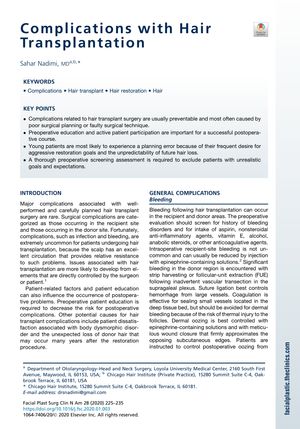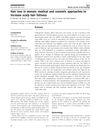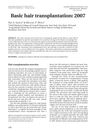Complications with Hair Transplantation
May 2020
in “Facial Plastic Surgery Clinics of North America”

TLDR Hair transplant complications are rare with good planning and technique, but risks include infection, bleeding, and patient dissatisfaction.
The document from May 2020 discusses complications associated with hair transplantation, emphasizing that while major complications are rare when the surgery is well-performed and carefully planned, issues can arise due to poor surgical planning or technique. It highlights the importance of preoperative education and patient involvement in reducing postoperative complications. Young patients are particularly at risk for planning errors due to aggressive restoration goals and the unpredictability of future hair loss. The paper also notes that complications such as infection and bleeding are uncommon due to the scalp's good circulation, but can occur in both recipient and donor sites. Preoperative screening for bleeding disorders and certain medications is crucial, and intraoperative bleeding can be managed with epinephrine-containing solutions or suture ligation, depending on the vessel size. Postoperative oozing can be controlled with proper wound closure and patient instructions. Additionally, patient dissatisfaction and unexpected loss of donor hair years after the procedure are potential complications.
View this study on doi.org →
Cited in this study

research Complications in Hair-Restoration Surgery
Hair restoration surgery can have complications; success depends on patient education, careful planning, and proper execution.

research Different options in revision surgical hair restoration
Different hair restoration techniques like follicular unit extraction, scalp reduction, and body hair transplantation can improve results for patients unhappy with their initial surgery, but they also have potential risks.
research Infection control and policy development in hair restoration

research A Protocol to Prevent Shock Loss
The document provides a method to avoid sudden hair loss after a hair transplant.
Related

research Is Every Patient of Hair Loss a Candidate for Hair Transplant?—Deciding Surgical Candidacy in Pattern Hair Loss
Not all hair loss patients are suitable for hair transplant due to various conditions like unstable hair loss, insufficient hair loss, very young age, unrealistic expectations, certain psychological disorders, and medical unfitness.
research Hair transplantation in androgenetic alopecia
research Hair Transplantation: Biochemical Basis and Surgical Treatment
Hair transplantation is a surgical treatment that uses your own hair to fill areas with thin or no hair.

research Hair loss in women: medical and cosmetic approaches to increase scalp hair fullness
Female pattern hair loss can be treated with medications, surgery, and cosmetic products, considering its psychological impact.

research Medications and hair transplantation
Minoxidil and finasteride combined can effectively treat hair loss.

research Basic hair transplantation: 2007
Hair transplantation has improved with techniques that increase graft survival and patient satisfaction for more natural results.
research A4. Hair loss – surgical and pharmacological treatment
Hair loss can be treated with medications like finasteride and surgical methods like hair transplants.

research Modern hair restoration surgery
Hair restoration surgery techniques have evolved, with focus on patient selection and realistic goals, and future advancements may include cloning and gene therapy.